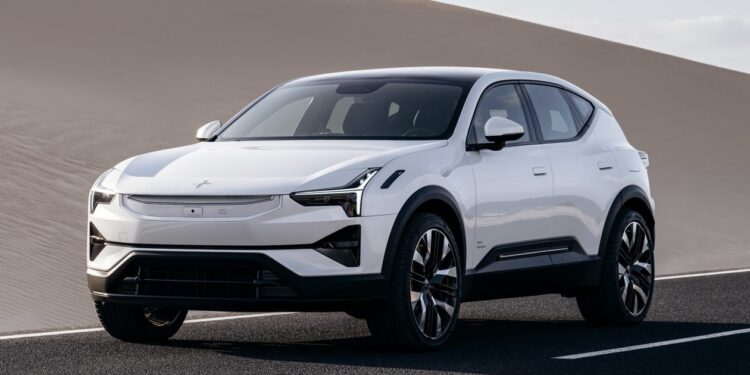The high-end electric SUV market is already hotly contested by the likes of the BMW iX and Audi Q8 e-tron. Now Polestar has entered the fray with this: the Polestar 3. It heralds the next-generation of Polestar models with a new electric car platform, revised interior tech and a starting price of £79,900. The 3 is available to order now through Polestar’s website and first deliveries are expected in late 2023.
Sharing its SPA2 platform with the new Volvo EX90, the Polestar 3 has a slightly smaller footprint than the BMW iX, and offers a dual-electric motor setup producing 482bhp and 840Nm. The firm is targeting a 0-62mph time of 5.0 seconds, and customers can opt for an even more potent Performance Pack model with 510bhp and 910Nm of torque. This costs an extra £5,600, and slashes the 0-62mph time to an estimated 4.7 seconds.
Both versions of the Polestar 3 top out at 130mph, and come equipped with a 107kWh (usable) battery pack. Polestar claims that up to 379 miles of range should be possible on the WLTP cycle, although this is subject to final testing. The battery can be topped up from 10 to 80 per cent in 30 minutes thanks to the car’s 250kW charging capability, and there’s bi-directional charging to feed power back into the grid.
Despite the 3’s 2,584kg kerb weight, Polestar has utilised an array of advanced chassis technologies to inject the car with some degree of athleticism. For example, the rear electric motor is a torque vectoring dual-clutch unit, and adaptive dampers have been fitted as standard. Dual-chamber air suspension also features, with Performance Pack models receiving a bespoke suspension calibration and 22-inch forged alloys for sharper dynamics.
Design and technology
The exterior design is recognisably Polestar, but the firm has taken inspiration from the Precept concept to refine the SUVs aerodynamics and styling. Unlike the Polestar 2, the front fascia doesn’t feature a blanked off grille, and instead uses a slim aero bridge that feeds air over the bonnet. Polestar’s T-shaped headlight design remains, and the 3 gets black lower panels on the bumpers and sills for a sleeker overall look.
The roofline tapers into a neat rear spoiler – again, for improved efficiency – there’s a slim rear light bar and “aero blades” at the outer edges of the bumper. The evolutionary theme continues inside, where the new SUV uses a development of the Android Automotive infotainment system from the Polestar 2. A 14.5-inch portrait touchscreen sits in the centre of the dashboard, and over-the-air updates should enable software improvements throughout the car’s lifecycle.
Initially, all Polestar 3 models will receive the Plus Pack as standard, which brings a host of extra equipment such as soft-closing doors, cabin air filtration, heated rear seats and a 25-speaker Bowers & Wilkins stereo. With a 484-litre boot, the Polestar trails the BMW iX by 16 litres, but it does offer a 32-litre front storage area – unlike its German rival.
A 9-inch instrument panel sits behind the steering wheel, and the cabin is finished using a blend of sustainable materials that include MicroTech fabrics, fully-traceable wool and animal welfare-certified leather. The Performance Pack adds flashes of gold inside, and all Polestar 3’s will arrive with a panoramic glass roof, ambient lighting, a 360-degree parking camera and a vast suite of driver assistance features.
These include a radar system which can scan for children or pets inside the car and adjust the climate settings accordingly, and an eye-monitoring camera to detect driver fatigue. A Pilot Pack will also be fitted to launch cars, which adds a parking assist function, adaptive cruise control and a head-up display
In total, there are five radar modules, five external cameras and twelve ultrasonic sensors to facilitate the 3’s safety systems, which can be expanded with the optional “Pilot Pack with LiDAR”. Set to be available towards the end of 2023, this includes three extra cameras and four additional ultrasonic sensors to scan the environment in real time, supporting the possibility of autonomous driving further down the line.


